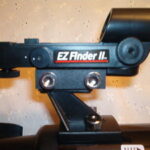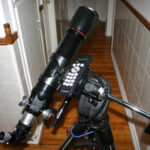The Celestron Powerseeker 50 is the telescope that every serious amateur astronomer has warned you not to buy. The Powerseeker has a .965-inch focuser. The Powerseeker 50 comes with three eyepieces (a Huygens 20mm and 12.5mm and an SR 4mm). The Powerseeker 50 comes with a useless 3x barlow and a 5x24mm finderscope that is nearly impossible to align. The Powerseeker 50 mount is a very shaky alt-az affair with spindly aluminum legs. The 50mm aperture of the Powerseeker is too small to see much more than the moon. The Powerseeker 50 really isn’t a telescope any rational person should buy. However, the Powerseeker 50 is awfully cute.
The little telescope does have a few things going for it. First, it seems to be assembled with a little more care and quality control than most toy telescopes. Second, it is very lightweight and would be easy for a child to move. Third, unlike many toy telescopes that have a plastic objective lens, the Celestron Powerseeker 50 has a coated glass objective. Fourth, the Powerseeker 50 is very inexpensive and would be no great loss if broken by a child. Fifth, it would be fine starter scope for someone who is most interested in observing the moon. Sixth, it comes with Celestron’s version of TheSky starcharting software. The software package alone is easily worth what I paid for the telescope. Finally, the Powerseeker 50 is awfully cute.
When I stumbled across an aggressively priced Powerseeker 50 at an electronics warehouse, I excitedly snatched up. It was cheaper than a pair of shoes. My excitement grew when I unpacked the telescope in the car, popped the diagonal on it, stuck in the 20mm Huygens eyepiece, and tested it handheld at 30x on a far off object down the street. The reversed image provided by the 90-degree star diagonal was perfectly acceptable for viewing terrestrial objects. Of course, due to the diagonal’s mirror, the image is reversed. Still, I didn’t think the optics were bad at all for the price.
When I got home, I put the little telescope together and thought it looked great. While the parts were typical of those found on most toy telescopes from China, the fit and finish were very good. The only obvious flaw seemed to be a single black blemish on the silver telescope tube. I was quite impressed by the lightweight and compact size of the telescope. It was easy to move one-handed through a door frame. However, the disappointments began when I took the Powerseeker 50 out on our balcony for more extensive testing. While the mount was easy to set up, it is very shaky with the legs fully extended. Every time I touched the focuser, the telescope vibrated for about 15 seconds rendering it difficult to focus quickly. The 5×24 finderscope was even more difficult to get adjusted and aligned with the main telescope. For some users, this will make it very difficult to effectively aim the Powerseeker 50 at celestial targets.
Later in the evening, I took the little Powerseeker 50 to my favorite urban observing site. I was able to get the telescope pointed at Orion’s belt and see the nebulosity of M41 and easily make out three of the four stars in the trapezium with the 20mm and 12.5mm eyepieces. The fourth star in the trapezium was difficult to make out because it was easy to lose the trapezium when I switched to a higher powered 9mm Huygens eyepiece of my own. When I did have it aimed correctly, I could not get the scope to stop vibrating and shaking enough to be sure that I was seeing the fourth star in the multistar system. I did not even test the 4mm Huygens with the Powerseeker 50 because I figured it would be useless. In testing, I was able to better align the finderscope using the lights atop of a distant office building. Despite the difficulties in seeing planets and deep space objects, the Powerseeker 50 is an excellent telescope for viewing the moon. You can aim it at the moon using the low power eyepiece and then switch to progressively higher powers. All a user has to do is get the moon lined up, focus, and don’t touch it except until the moon has moved out of view. On a bright object like the moon, the Powerseeker 50 should be able to provide up to 150x magnification using the included 4mm Huygens eyepiece. However, a 6mm Huygens eyepiece might have been a better choice. With a little online research into a set of lunar features called the Lunar 100 and a suitable moon map, the Powerseeker 50 will provide many hours of lunar observing. This telescope would not be a good choice for observing planets or deep space objects.
The concept of a 50mm telescope aimed at kids and adult tinkerers is valid. The Celestron Powerseeker 50 is an optically decent telescope and there are several very easy changes that Celestron could make to this product to make it better for end users and more profitable for themselves. First, Celestron could delete the finder scope entirely and replace it with a firearm-style blade sight and a dovetail plate to allow the attachment of a red-dot finder by the user. A 50mm telescope is simply not going to be used on targets that are not apparent to the naked eye. There is no reason to frustrate kids with a bad 5×24 finderscope. Second, Celestron could easily provide a 45-degree correct image diagonal. This would broaden the appeal of the Powerseeker 50 to include birdwatchers, target shooters, and others who might use it as a spotting scope. A correct image diagonal would make it easier to find objects on lunar maps. Third, the current telescope tripod should be replaced by an inexpensive photography-style tripod with a standard 1/4-20 mount. Fourth, a 1.25-inch focuser should be provided and 1.25-inch Huygens eyepieces should be standard. Fifth, a users manual should include a lunar map and a subset of the lunar 100 aimed at children and other novice users.
These changes would transform the Powerseeker 50 into a “razor” and Celestron could rake in plenty of money by selling improvement accessory “blades” like decent 1.25-inch Kellner eyepieces, red-dot finders, better tripods, star diagonals, filters, and lunar maps. In addition, each accessory purchase could provide a valuable customer contact and the opportunity to sell the consumer on the benefits of a better Celestron product. I’d love to see Celestron transform this product into the definitive starter refractor for children. If you need replacement eyepieces or would simply like to increase the size of your eyepiece collection, .965-inch eyepieces are readily available at various online auction sites and specialty retailers like The SurplusShed.com.
The saving grace for this little telescope is that it is cheap enough for any tinkerer to economically make these improvements on their own. Many amateur astronomers will already have the required parts laying around their workshop or will be able to easily find them in the broader astronomy marketplace. A hybrid-diagonal would allow the telescope to use 1.25-inch eyepieces. The red-dot sight from a BB-gun would make it much easier to aim this scope. All of the improvements that can typically made to a Department Store Telescope (DST) can be easily made to the Celestron Powerseeker 50. If you are willing to invest a little time and money, the Celestron Powerseeker 50 can be the foundation for a decent grab-n-go project telescope scope for lunar observing or birdwatching. With just a little effort, you can probably turn this inexpensive telescope into the classic it should have been in the first place. For a child or for an observer interested in a lightweight telescope for observing the moon, a little work invested into this scope might be worthwhile. After all, the Celestron Powerseeker 50 is really cute.





